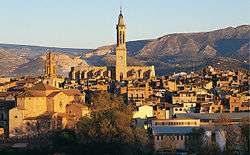Valls
| Valls | |||
|---|---|---|---|
| Municipality | |||
 | |||
| |||
 Valls Location in Catalonia | |||
| Coordinates: 41°17′18″N 1°15′7″E / 41.28833°N 1.25194°ECoordinates: 41°17′18″N 1°15′7″E / 41.28833°N 1.25194°E | |||
| Country |
| ||
| Community |
| ||
| Province | Tarragona | ||
| Comarca | Alt Camp | ||
| Government | |||
| • Mayor | Albert Batet Canadell (2011)[1] | ||
| Area[2] | |||
| • Total | 55.3 km2 (21.4 sq mi) | ||
| Elevation | 215 m (705 ft) | ||
| Population (2015)[1] | |||
| • Total | 24,321 | ||
| • Density | 440/km2 (1,100/sq mi) | ||
| Demonym(s) | Vallenc | ||
| Website |
valls | ||
.jpg)
.jpg)
Valls (Catalan pronunciation: [baʎs]) is the capital of the comarca of Alt Camp, in Catalonia, Spain. According to the 2014 census it has a population of 24,570.
Valls is known for its calçots – a type of scallion or green onion – and the human towers tradition known as the castells. The town is the birthplace of the composer Robert Gerhard (1896–1970).
Geography
Valls is a city and municipality in the province of Tarragona in Catalonia in northeastern Spain. It is the capital of the county of Alt Camp. With a population of 24,570 inhabitants in 2014, it represents more than half of the population of the county.[2] It is located in the area known as Camp de Tarragona next to the River Francolí, near Reus (Baix Camp) and Tarragona (Tarragonès), the capital of the province.[3]
Culture
Valls is known for its culinary tradition, the feasting on calçots at what is known as a "calçotada". The calçots are a large type of sweet-flavoured spring onion, barbecued over a pit of flaming vines, and eaten piping hot with a sauce. The calçotada continues with a main course of meats and sausages grilled over the same glowing coals, and is washed down with locally produced wines. The calçots are only available between December and May and draw diners from as far away as Barcelona. The calçot is grown locally and has a "PGI" (Protected Geographical Indication) status in the same way that champagne does.[4]
Another cultural tradition of Valls is the practice of building "castells" at festivals, pyramids of people sometimes as much as twelve individuals high, with each layer being supported by the people below.[5] This human tower tradition originated in the Ball dels Valencians in Valls, first recorded in 1712,[5] and later spread to nearby towns such as Vilafranca del Penedès and Tarragona, and more recently, to other parts of Catalonia.[6]
The composer Roberto Gerhard was born in Valls in 1896. He studied under Charles Koechlin in Paris and under Arnold Schoenberg in Vienna and Berlin before returning to Barcelona in 1928. During the Spanish Civil War he supported the Republican cause and was forced to flee the country in 1939, first to Paris and then to England where he spent the rest of his life, meanwhile his town was bombing and a lot of republican and catholic citizens killed. His works were virtually banned from performance in Spain under Francisco Franco. His output included symphonies, stage works, chamber music, choral music and electronic music.[7]
Twin towns
References
- 1 2 "Ajuntament de Valls". Generalitat of Catalonia. Retrieved 2015-11-13.
- 1 2 "El municipi en xifres: Valls". Statistical Institute of Catalonia. Retrieved 2015-11-23.
- ↑ Philip's Modern School Atlas. George Philip & Son. 1973. p. 37. ISBN 0-540-05278-7.
- ↑ Scott-Moncrieff, Chloe (8 March 2014). "Calçots in Catalonia, where they know their onions". Independent. Retrieved 1 October 2015.
- 1 2 Català i Roca, Pere. "Els castells dels xiquets de Valls". Valls sons i musiques de festa (in Catalan). Retrieved 9 November 2015.
- ↑ "Los 'castells', Patrimonio de la Humanidad" (in Spanish). El País. 16 November 2010. Retrieved 9 November 2015.
- ↑ "Roberto Gerhard Biography". Boosey & Hawkes, Inc. Retrieved 2 October 2015.
- Panareda Clopés, Josep Maria; Rios Calvet, Jaume; Rabella Vives, Josep Maria (1989). Guia de Catalunya, Barcelona: Caixa de Catalunya. ISBN 84-87135-01-3 (Spanish). ISBN 84-87135-02-1 (Catalan).
External links
| Wikimedia Commons has media related to Valls. |
- Official website (Catalan)
- Information – Generalitat de Catalunya (Catalan)
- Statistical information – Institut d'Estadística de Catalunya (Catalan)
 |
Montblanc | Figuerola del Camp | El Pla de Santa Maria |  |
| La Riba Alcover |
|
Alió | ||
| ||||
| | ||||
| El Milà La Masó |
Vallmoll | Puigpelat |

